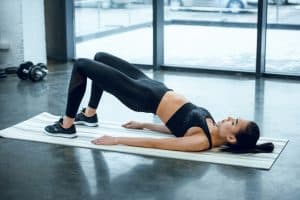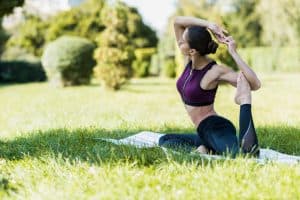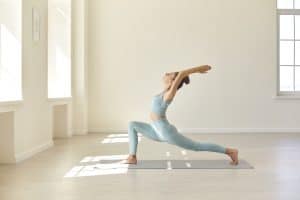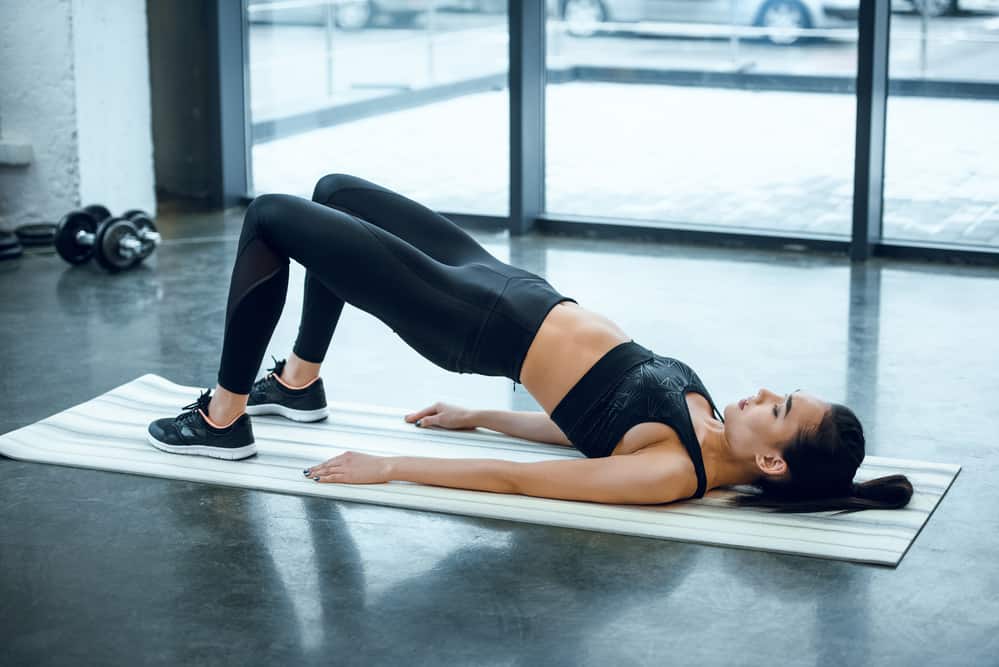If you’re a runner, you know how unpleasant tight hips can be. They’re painful, uncomfortable, and plain annoying.
That’s why having the right hip stretches is so important. Luckily, this problem is easily fixed with a few easy moves to enhance your mobility and get you running faster and longer.
So, let’s loosen up any tightness with the top 10 hip stretches for runners. They’ll help increase mobility and reduce pain.
Here we go.
What Are Hip Stretches for Runners and Why Are They Important?

Hip joints connect the leg to the trunk of the body. It’s made up of two bones: the pelvis bone and the femur, or thigh bone.
The hip moves and rotates using a group of muscles called the hip flexors. These muscles are responsible for the full range of mobility in your upper and lower body, like walking, flexing, bending, and much more.
As a result of daily activities, these muscles sometimes become shorter and tighten up. This can limit even the simplest of moves and make them painful.
The good news is you can easily loosen up your hips. Yet, before we get stretching, let’s talk a bit about the five muscles that make up our hip flexors and how each one functions.
Psoas Major Muscle
The psoas muscle is a long, tapering muscle. Its point of origin begins at the sides of your spine and crosses over to reach the top part of the femur.
When you flex your hip or raise your leg, this muscle contracts and shortens. It also helps in the lateral rotation of the thighs at the hip joint.
Iliacus Muscle
This muscle is triangular and connects the ilium to the highest point on the femur.
It’s often grouped with the psoas muscle. Together, they allow you to stand erect and get up from a seated or lying position. Plus, they’re responsible for helping you bend from the waist.
Rectus Femoris
Also part of the quadriceps muscles, the rectus femoris makes up a significant portion of the hip flexors.
It has two primary functions. The first one is to help you extend your leg at the knee. So, when you kick a ball or swing your leg forward, you’re using your rectus femoris.
Sartorius
The sartorius is the longest muscle in your body. Starting at the back of your spine, it extends downward, crossing over the hip and the knee.
It helps flex and bend the hips, raise the thigh muscles, and rotate the legs. Like the rectus femoris, you use this muscle when kicking a ball, especially with sideway kicks where your leg moves across your body.
Pectineus
The pectineus muscle is the one nearest to your spinal cord. It acts as a secondary adductor after the sartorius.
This small muscle plays a significant role in the flexing and lateral bending of the hips and upper body. Another function is it helps rotate the thigh internally to give you a wider range of motion.
The 10 Best Hip Stretches for Runners
When you suffer from tight hip flexors, it can lead to many ailments—from poor
posture to Achilles tendonitis and everything in between.
1. Garland Pose
The garland pose isn’t only about stretching; it requires a bit of stability. It might take a few tries to get the balance right, but you’ll be able to master it with a bit of practice.
This pose is also great for opening up your thigh muscles, both inner thighs and quads. Plus, it gives your groin muscles a bit of stretch for added maximum.
For best results, do 2 – 3 sets of 10 repetitions each.
2. Head to Knee Pose
As you sit on the ground, stretch one leg in front of you. Bend the other one and place the sole of the bent foot on the inner thigh of your outstretched leg. With your back as upright as possible, lean forward. Reach for your toes and hold for at least five counts.
If you can’t reach your toes, try to go as far as you comfortably can. The more you practice, the more flexible you’ll become.
The wonderful thing about this pose is that it doesn’t just open up the hip flexors. It also stretches out your back muscles and hamstrings.
3. Knees to Chest Pose
The knee to chest stretch pose is a fun and simple way to open up tight hip flexors and regain flexibility. It also loosens lower back and hamstring muscles, just like the head to knee pose.
Start by laying flat on the floor. Pull your knees close to your chest and hold for no less than 30 seconds. Repeat 2 – 4 times for best results.
Some people prefer to rock back to front or side to side. They feel that the gentle motion eases tightness in the hips and lower back.
4. Pigeon Pose

To do the pigeon pose, start by getting on your hands and knees. Then, slide your right knee behind your right wrist, with your right shin on the floor.
Stretching your left leg out behind you, lay the top of your left foot flat on the floor. Make sure your back is straight, and your spine is extended.
If you feel you’re slightly off-balance, use your hands to stabilize yourself. Hold for at least 5 seconds before moving on to the other leg.
This pose might seem tricky, but it’s great for opening up your glutes, hip flexors, and psoas muscles. It’s also a deep stretch that helps relax your glutes and lower back
5. Seated Butterfly Pose
The seated butterfly pose is similar to the Garland stretch. The difference is that the butterfly pose doesn’t need as much balance.
In this simple stretch, sit on the floor with your feet together. Point your knees outward and bring them in as tight as you can.
Straighten your back and lean slightly forward to feel a slight stretch on your inner thighs. You can give a gentle push on your thighs with your elbows for an even deeper stretch. Hold for no less than 15 seconds and repeat 2 – 4 times.
6. Seated IT Band Pose
Also known as the Hollywood stretch, the seated iliotibial (IT) band effectively opens up hip flexors and outer thighs. Start by sitting on the ground with both your legs in front of you.
Bend the left leg and pass it over the right. The foot of your bent leg should be resting comfortably on the ground, near your right knee.
Gently twist in the direction of the bent leg. To get an even deeper stretch on the outer hips, place your elbow on the left knee and give a slight push.
Try to hold the stretch for up to 20 seconds before releasing and repeating with your right leg. Repeat 2 – 4 times on each leg.
7. Standing Camel Pose
There are two levels to this standing camel pose: easy and advanced.
For the easy level, stand with your feet shoulder-width apart. Place your hands on your waist and roll back your shoulders.
Start to bend your upper body backward. Take your time and move slowly.
As soon as you feel a nice stretch in your lower back and hips, hold it for about 5 to 10 seconds. Then, slowly return to the starting position. Repeat for at least five times.
The more advanced level is the same. The only difference is you’ll need to get on your knees instead of standing on your feet.
This will deepen the stretch in your hips and back. Plus, it’ll loosen your quads and inner thighs.
8. Standing Lunge Pose

Start with your feet hip-width apart. Take a step forward with your left leg and slowly lower your body until your right thigh is parallel to the floor.
This pose might be a bit challenging because you need to maintain your balance. So, it’s okay if it takes you a few tries before you find the stability you need to hold this pose.
Once you find your balance, hold the stretch for 30 seconds. Then, stand back up with your feet together. Repeat 2 – 4 times on each leg.
Besides opening up your hip flexors, this pose is amazing at strengthening butt and thigh muscles. It also releases tightness in your inner thighs and hamstrings.
9. Supine Pigeon Pose
The supine pigeon pose is a terrific option if you have difficulty with the standard pigeon pose. It’s extremely useful if you suffer from bad knees or overly tight hips.
First, lie down on the floor. Bend both knees, then lift your right leg slightly in the air. Next, take your left leg and cross it over your right thigh.
You can always apply more pressure. Simply pull your right leg toward you and hold to deepen the stretch.
Hold for 5 – 10 seconds. Then, switch legs and repeat 2 – 4 times for each leg.
This stretch is also called ‘reclined pigeon pose,’ ‘eye of the needle,’ and ‘lying figure 4 pose.’
10. Wide-Angle Seated Forward Bend Pose
Also referred to as the seated saddle stretch, this pose does wonders for opening up your hips, lower back, hamstrings, and calves.
The trick to this pose is in the way you stretch out your legs. The wider the angle, the deeper the stretch.
Extend your spine and gently lean forward and reach your hands in front of you. Hold this stretch for a maximum of 30 seconds. Repeat 2 – 4 times.
Your aim should be that you stretch as far as you can without bending your knees. If you can’t at first, don’t worry. You’ll get there with
practice.
Final Thoughts On Hip Stretches for Runners
We hope these hip stretches for runners into your warm-up, and cool-down routines are essential to staying healthy.
Incorporating these stretches into your weekly workouts will boost your speed and flexibility. Remember, the shorter the muscle, the shorter the stride.
Thus, stretching these muscles will definitely give your running performance a nice boost.
The best part is that they’re easy to do. Just start small and work your way through these stretches. The more you do them, the easier they’ll become.
Plus, they only take a few minutes. So, you can fit them easily into your exercise routine for stronger muscles and resilient, more supple joints.

